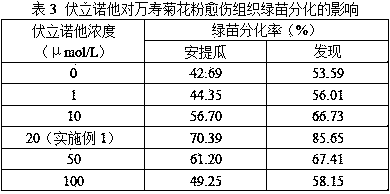Marigold pollen differential medium and differentiation culture method
A technology of differentiation medium and culture method, which is applied in the field of marigold pollen differentiation medium and differentiation culture, can solve the problems of low callus induction rate, inability to accurately judge, low haploid, etc., and improve the differentiation rate of green shoots , the effect of promoting callus differentiation
- Summary
- Abstract
- Description
- Claims
- Application Information
AI Technical Summary
Problems solved by technology
Method used
Image
Examples
Embodiment 1
[0028] A kind of marigold pollen callus differentiation culture method, comprises the steps:
[0029] 1) Two marigold varieties 'Antigua' and 'Discovery' were used as test materials, and the pollen microspores were isolated for induction culture. When the callus grew to a size of 2-3 mm, the callus was inoculated into The light and dark cultures were alternately cultivated on the differentiation medium. The temperature of the light culture was 25°C, the light time was 12h / d, the light intensity was 1500lx, and the temperature of the dark culture was 22°C. After 3~4 weeks of culture, the callus differentiated into test-tube plantlets , when culturing for 30 days, the green shoot differentiation rate was counted, and the green shoot differentiation rate (%)=the number of calli that differentiated into green shoots / the total number of inoculated calli × 100%;
[0030] The formulation of the differentiation medium used is: KNO 3 1800mg / L, NH 4 NO 3 1450mg / L, KH 2 PO 4 ·H 2 O...
Embodiment 5
[0050] Embodiment 5: Ploidy identification test of regenerated plants
[0051] Adopt flow cytometer to carry out ploidy identification to the regenerated plant that embodiment 1 obtains, and specific method is: take more than 1cm 2 The leaves of the plant were chopped with a sharp blade in a 55mm petri dish, and 400uL of extract (15mol / LTris-HCl (pH7.5), 80mol / LKCl, 20mol / LNaCl, 20mol / LEDTA-Na 2 , 15mol / L mercaptoethanol, 0.05% Triton X-100). Leave it for 1 minute, then filter it with a 50 μm microporous nylon mesh, collect the filtrate in a standard test tube for on-machine testing, then centrifuge at 1000r / min for 8 minutes, discard the supernatant, and then add 1mL of propidium iodide staining solution , stained in the dark and low temperature for 20 minutes, and then tested on the machine, the results are shown in Table 5.
[0052]
[0053] It can be seen from Table 5 that in the regenerated plants of 'Antigua', the haploid rate was 35.6%, and the diploid rate was 56....
PUM
 Login to View More
Login to View More Abstract
Description
Claims
Application Information
 Login to View More
Login to View More - R&D
- Intellectual Property
- Life Sciences
- Materials
- Tech Scout
- Unparalleled Data Quality
- Higher Quality Content
- 60% Fewer Hallucinations
Browse by: Latest US Patents, China's latest patents, Technical Efficacy Thesaurus, Application Domain, Technology Topic, Popular Technical Reports.
© 2025 PatSnap. All rights reserved.Legal|Privacy policy|Modern Slavery Act Transparency Statement|Sitemap|About US| Contact US: help@patsnap.com



